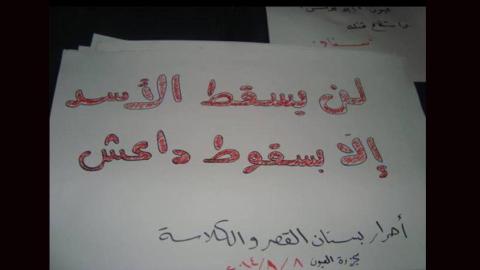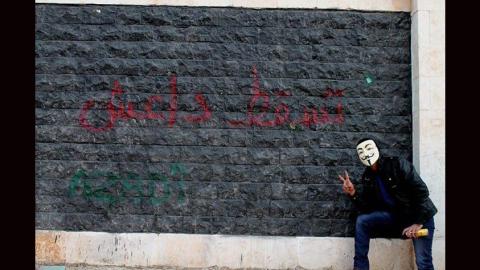Despite all the attention devoted to the opposition militias’ offensive against the radical group, Islamic State in Iraq and Syria (ISIS), that started in December 2013, the fact remains that it was the civil activists who rose up first against the group. Syria Untold has reported on this civil resistance, both in Aleppo and Raqqa, to ISIS’s policies and crimes in great depth over the past few months.
According to Kurdish activist Hawzan Ibrahim, the resurgence today in demonstrations and nonviolent activism against ISIS comes as a reminder of its primacy over military resistance, and its crucial role as a backbone for such action. It is also reminiscent of the early days of the revolution in its inclusive messages and emphasis on Arab-Kurdish fraternity. These demonstrations that spread to many neighborhoods and towns around Aleppo and Raqqa raised banners of the unity of the struggle against both tyrannies, ISIS and Assad: “Resist ISIS and Assad. Syrians are forever free”, “Assad and ISIS are one and the same”.
The Arab-Kurdish Fraternity Coordination Committee was one of the first to rise up against ISIS and organize demonstrations demanding the release of detainees in the Ashrafiya quarter in Aleppo on January 4, 2014. The fraternity, which also supported the Free Syrian Army (FSA) in its campaign against ISIS, maintains that what is happening today is a direct result of the series of tragic violations committed by the group. Guevara Naby, the fraternity’s general coordinator, adds: “Let the end of this boogyman be a lesson to whomever attempts to hijack our revolution. Let this be a rebirth for the civil movement to restore its momentum and the confidence of the public, for we have many more groups like ISIS, albeit in different shapes and colors, to fight against.”

Naby thinks that this second awakening will not stop with ISIS but will continue to overtake all other radical Islamist movements like al-Nusra Front. He strikes a defiant tone in telling them that “we have not forgotten your violations against the revolution and those carrying its flags. You shall be punished for that.”
Nevertheless, this is by no means the view of all activists. There is a significant disagreement between those who believe that this second revolution should be limited to ISIS because of its unquestioned barbarity, and those who believe that this must be extended to all other militias with a radical Islamist agenda, including al-Nusra Front, Islamic Front, Army of Mujahideen, and others.
Other activists, like Mais Katt, founder of Radio Rozana, go as far as to consider this no more than another nail in the coffin of a revolution that has already burned out. She says: “The attack against ISIS is nothing more than political maneuvering. It was only weeks ago that the FSA was declaring areas under ISIS control as ‘liberated territory’, and now they want to liberate it again? The revolution has ended a while ago, in my opinion, and this is just a pointless bloodbath.”
On the other side, activist and physician Ali Diab thinks that there will not be a need for a more extensive campaign against al-Nusra and other Islamist militias. Diab believes that “what is important is to emphasise the revolution’s ideals, and to correct its trajectory, and this should be a forgone conclusion after what happened with ISIS.” Nancy Ahmad, however, believes that “the revolution against ISIS must affect real change in the revolution’s landscape. Radical Islamist forces must realize that what applies to ISIS will apply to them too. For just because they are fighting against that group doesn’t mean that they don’t share the same ideology and the same disregard for basic human rights.”

Media professional Fadia Abu Zeid believes that the root of the revolution’s malaise is the existence of these radical Islamist groups, not just ISIS. Abu Zeid adds: “The only way to correct this is by excluding all of these groups. This can only be done if Syrians decide to reclaim their revolution back.”
The war on ISIS has also resurrected the old debate between activists on the advantages and disadvantages of militarism and peaceful resistance. Mais Katt believes that “the civil voices that are raised every once in a while are but timid attempts to preserve the values of freedom and democracy that had for so long driven Syrians in their uprising.”
Syrian writer Delمair Youssef, however, sees these latest examples of civil resistance as “proof of the Syrian people’s ability to resist the most barbaric of criminals using civilized means, and their brilliant creativity under such harsh conditions.” Youssef continues: “The revolution started against a tyrant, and it will continue against anyone who attempts to curtail its freedom. A people who rebelled against Assad will not tolerate another tyrant.”
Syrian political analyst, Afraa Suleiman, believes that the return of nonviolent resistance is reminiscent of the “first days of the revolution, when the uprising was still in Syrian hands. Personally, I don’t believe that violence can ever bring peace or an improvement to our conditions, nor can it bring forward a rapid conclusion for the struggle or minimize casualties, as suggested by those behind it. What has happened since the revolution became militarized is sufficient proof.”
The war on ISIS, regardless of how one approaches it, brings ample proof that Syrians are resisting all manifestations of tyranny, including those imposed in the name of the revolution. It also proves that civil nonviolent resistance is still alive under the ashes. When the guns, eventually, fall silent, it will re-emerge.



